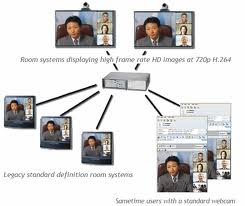Email is great for one-one-one communications that aren’t time sensitive. Instant messaging is better for time-sensitive communications, but it’s still essentially a one-on-one medium.
When you need to include more than two people in your communications, or when you want to give a presentation to a group of people who aren’t all in the same location, a different communications tool is needed. This new tool is called a web conference, and it’s a way to conduct live meetings and presentations over the Internet.
In a typical web conference, each participant sits at his own computer in his own location. Each participant’s computer is connected to the conference via the Internet, and each participant sees the presentation on his or her screen, in real time.
A web conference can be one way, as when the presenter delivers some sort of PowerPoint-like presentation, or two way, where each participant can join in and show the contents of their active applications or desktops. Communication between participants can be audio only (via streaming audio, VoIP, or traditional telephony) or include audio and video (typically using webcams).
Most web conferencing services are hosted on the vendor’s servers. You typically have to arrange a conference in advance, and the hosting service will help you set everything up. Depending on the vendor, this can be a costly service, viable only for larger organizations. Make sure you check the price before you commit to using a particular service. What features can you expect from a web conferencing service? Here are some of the most common:
Application sharing, where the presenter and participants can all access and use the same application in real time. This is useful for smaller group meetings, when all participants are collaborating on a project.
Desktop sharing, similar to application sharing, but with the presenter’s entire desktop visible and accessible to participants.
File and document sharing, with individual files and documents open for all to edit, also useful for group collaboration.
PowerPoint presentations, the core component of large presentations; the presenter gives a PowerPoint presentation in real time, complete with slide transitions and animations, using audio conferencing tools to narrate the presentation.
Presenter notes, which let the presenter take notes during the course of
the conference for future action.
Annotation, which lets the presenter mark up the document or presentation being shared or given, typically by drawing or highlighting on the screen.
Whiteboard, which is a blank screen on which the presenter or participants can draw or highlight objects.
Text-based chat, which lets participants discuss the presentation witheach other in real time.
Audio conferencing, which adds the spoken words of the presenter to a PowerPoint presentation. With two-way audio, all participants can speak—assuming that they all have microphones, of course.
Video conferencing, which puts a picture of the presenter in a corner of the conference webtop, typically generated via webcam. With twoway video, conference participants can also show pictures of themselves on-screen.
Polling, which lets the presenter ask questions of the audience.
Quizzes, which lets participants answer test questions, typically with results tabulated in real time.
Some web conferencing systems will have all of these features; others will have a subset. Look for services that offer those features essential to your particular needs.
Below is a collection of some the commonly used web conferencing tools;
WebEx
Cisco’s WebEx (www.webex.com) is perhaps the most-used web conferencing solution today. Various solutions and pricing plans are available, for organizations large and small. Features include VoIP support, integrated audio and video, application sharing, on-the-fly annotation, meeting recording and playback, and so on.
Adobe Acrobat Connect
The Adobe Acrobat Connect (www.adobe.com/products/acrobatconnect) software and service offers personal online “meeting rooms” for large organizations. For atleast $39/month (and up), you get audio/video conferencing, screen sharing, whiteboard, and chat functionality.
Convenos Meeting Center
The Convenos Meeting Center (www.convenos.com) is a web-based conferencing service that starts at $30/month. For that price, you get online presentations, file and document sharing, whiteboard, polling (the ability to ask questions of your audience), and integration with Skype for conference audio.
Genesys Meeting Center
The similarly named Genesys Meeting Center (www.genesys.com) offers similar features to that of the Convenos service. Genesys gives you online PowerPoint presentations, file and document sharing, chat, desktop video, whiteboard, and polling and E-Quizzes. Pricing is by request only.
Glance
Glance (www.glance.net) is a web-based conferencing service priced from $49.95/month. Its main focus is easy-to-use screen sharing, with no client software necessary to install.
IBM Lotus Sametime
IBM’s web conferencing service is dubbed Lotus Sametime (www.ibm.com/ sametime/), and it comes in several different versions: Entry, Standard, Advanced, and Unyte. The web conferencing service comes complete with enterprise instant messaging, multiway chat, VoIP and point-to-point video, and integration with most major desktop applications. Pricing varies by size of company.
Microsoft Office Live
Meeting
Microsoft Office Live Meeting (www.office.microsoft.com/en-us/livemeeting/) is a hosted service available in two versions (Standard and Professional). You get audio/video conferences, a PowerPoint viewer, integration with Microsoft Outlook, application and desktop sharing, and the like. Pricing is on a peruser basis, with volume licensing available.
Zoho Meeting
Last but not least, Zoho Meeting (meeting.zoho.com) is, for now at least, a free web conferencing service. It includes the expected features, including application/desktop sharing, chat, and Skype integration, as well as remote PC control.




{ 2 comments... read them below or add one }
Hey thanks a lot for sharing this post. I have been using free web conferencing since a long time now and it works great. It is very user friendly and works all the time for me.
We are using peoplelink InstaVC which is a WebRTC video conferencing software, give presentations, have productive discussions, and come up with the next great idea for your business
Post a Comment